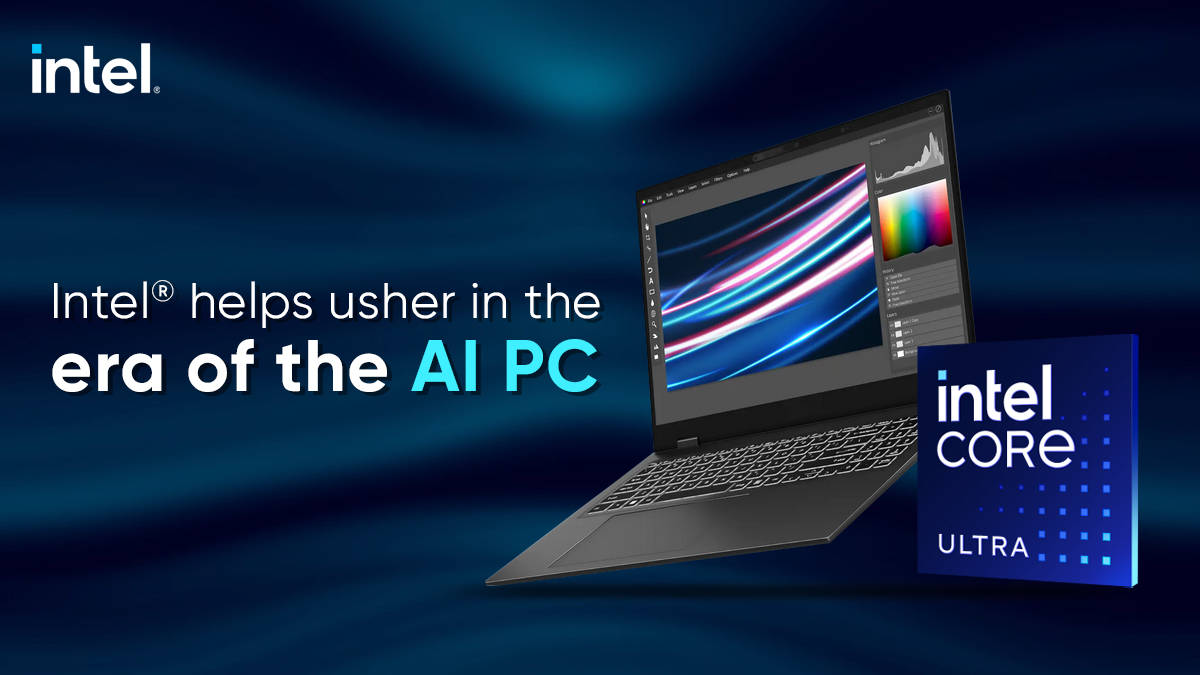
AI is becoming increasingly common in our daily lives, so it was only a matter of time before it found its way into our personal computers. Intel® is leading the AI charge with its latest Intel® Core™ Ultra Processors. These new chips are specifically designed to tackle AI-based tasks, signalling the dawn of the AI PC era. With these processors, devices can perform tasks in a smarter, more efficient manner, ultimately enhancing overall user productivity and experience.
What is an AI PC?
One can think of an AI PC as an evolution of the PC we use today. It is specifically designed to take on AI and machine learning tasks. Traditionally, processors would only feature a CPU and GPU and these would be used to handle any AI-related task or the processing would happen offsite via the cloud. The new Intel® Core™ Ultra Processors add a new unit called the Neural Processing Unit (NPU). This is specifically made to handle AI and ML tasks directly on the PC instead of heavily relying on the CPU and GPU or the cloud.
Of course, a CPU and GPU could still handle AI tasks but having an NPU that is built into the system opens up a whole host of possibilities. For starters, it decreases the load on the CPU and GPU by taking care of any low-power AI calculations. Further, by reducing the dependency on the Cloud, these calculations are faster and more secure.
What can an AI PC do for us?
The current generation of AI PCs powered by Intel® Core™ Ultra Processors can already do a lot of things. For example, using the text-to-image feature in software like Blender or GIMP, anyone can create any image via a short text description. This is especially useful for advertisers, marketing executives as well as designers who want to quickly create images best suited to their needs.
But that is just the start. Photo and video editors can also call upon AI when using Adobe Lightroom or OBS Studio. AI can help with more natural-looking filters while with the added benefit of faster exports. Not just that, they also get the added benefit of automated and quicker searches.
Professionals can also see a boost in productivity thanks to AI. For example, with Windows Studio Effects, users can use features such as Smart Scene Framing, Eye Gaze Correction and Low Power Back Ground Blur. This will help ensure that video conferencing sessions are more productive with minimal distractions. Further, software such as Rewind can help offer a more personalised digital assistant that is more in line with your requirements.
Gaming and entertainment will also get a boost with AI. For example, gamers could see even better fidelity thanks to improved 3D animation as well as game upscaling with Intel® XeSS. Multiplayer games also benefit from live transcription and chat translation.
Everyday usage will also change thanks to AI. Imagine how much help AI can offer when it comes to things such as writing, coding or even text prediction with the added bonus of a smarter grammar check that does more than just autocorrect words. PC security and privacy will also see an improvement with your computer being able to automatically detect any initial indicators of an attack and automatically move to protect sensitive data. It would also improve security scans by keeping an eye out for any real-time threats. Finally, and most importantly, it would make PCs even more accessible to people with disabilities through AI-assisted audio-visual capabilities.
So how are the Intel® Core™ Ultra Processors going to usher in the era of the AI PC?
For starters, the new Intel® Core™ Ultra Processors are packed to the brim with the latest hardware. As discussed earlier, the new addition to the latest processors is the NPU. These will work in tandem with the CPU and GPU when dealing with any AI-based task. The NPU will handle any high-end AI-based task while the CPU and GPU can deal with the low-end AI-based tasks. Intel® has branded its NPU Intel® AI Boost and notes that it enables 2.5x better power efficiency than the previous generation.
It should also be noted that the new Intel® Core™ Ultra Processors offer up to 16 cores and 22 threads of performance. Further, the new processors feature an evolved version of Intel’s Performance Hybrid Architecture. The cores are divided between Performance Cores (P-Cores), Efficiency Cores (E-Cores) and Low-Power Efficiency Cores (LP E-Cores). As was the case before, the P-Cores are ideal for single-threaded workloads, while E-Cores are optimised for scaling multi-threaded workloads. Meanwhile, the new LP E-Cores are best used for scalable multithreaded performance and offloading background tasks. Helping this out is the fact that users can get Intel® Arc GPU, which will allow users to indulge in some casual gaming with impressive levels of performance, immersive video streaming and creation.
All this allows the new Intel® Core™ Ultra Processors to offer better performance and responsiveness while also improving overall efficiency for even better battery life. A win-win situation from all angles. Aside from all this, the new processors also offer support for fast charging, multi-device connectivity, QHD low-power displays, the latest Wi-Fi standards, better video cameras, and more. As a result, laptops powered by Intel® Core™ Ultra Processors should be packed with the latest and most cutting-edge features.
As one can see, the arrival of Intel® Core™ Ultra Processors marks the start of a new era for PCs, making them smarter and more powerful. These processors include special units called Neural Processing Units (NPUs), which make tasks run smoother and faster. They bring a lot of benefits, like helping with work tasks, making games more fun, and even making computers easier to use for people with disabilities. With better performance, longer battery life, and support for the latest features, Intel® Core™ Ultra Processors are leading the way in making PCs better than ever before.


